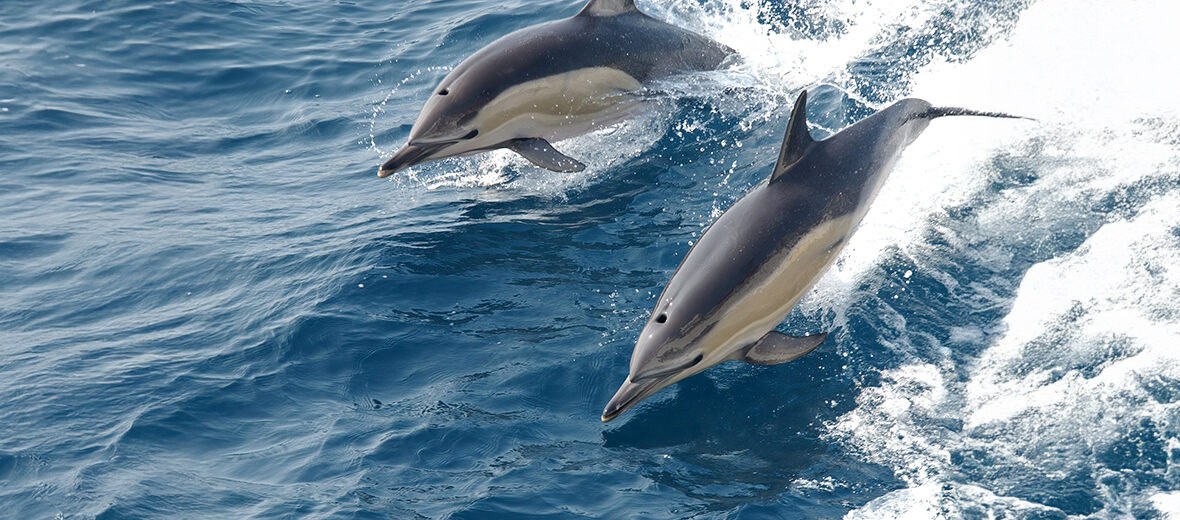
The common dolphin is, by far, the most bountiful cetacean in the world, with an estimated global population of approximately 6,000,000. They are found off the shores of every continent in the world sans Antarctica. Being this abundant has its downsides too, as they face several threats such as overfishing and over harvesting of their food; land pollution; water pollution; microplastics pollution; and climate change, that affects the water temperatures and subsequently can alter their habitats. They are abundant enough though to be listed as Least Concern by the IUCN. Their population trend is undocumented at this point. Welcome to Critter Science’s 1,800th critter article!
First the Stats…
Scientific name: Delphinus delphis
Weight: Up to 518 lbs.
Length: Up to 8.2 feet
Lifespan: Up to 35+ years
Now on to the Facts!
1.) These dolphins have been frequently depicted in Ancient Greek and Roman art and culture, most notably in a mural painted by the Greek Minoan civilization.
2.) They belong to the subfamily Delphininae, making them closely related to the 3 different species of bottlenose dolphins, Clymene dolphins, humpback dolphins, spinner dolphins, striped dolphins, spotted dolphins, Fraser’s dolphins, the tucuxis and Guiana dolphins.
3.) These dolphins have up to 60 small, sharp, interlocking teeth.
4.) They were first described by Carl Linnaeus, the Swedish naturalist, in 1758.
5.) Common dolphins dwell in both warm-temperate and tropical waters.
But wait, there’s more on the common dolphin!
6.) A variety of fish, squid, and octopus are all on the menu.
7.) Often times they can be found in areas that have certain geological factors such as underwater canyons and ridges seeing as this is where up-welling occurs which results in greater nutrient availability.
Did you know…?
These dolphins can dive to depths of up to 660 feet, and hold their breath for up to 10 minutes at a time.
8.) Pods can consist of 100s or even 1,000s of individuals!
9.) Sometimes, different pods will join together to form mega-pods which can consist of over 10,000 dolphins!
10.) Genetic research has indicated that common dolphins dwell in fission-fusion societies, where dolphins form pods that aren’t necessarily stable and thus do not necessarily consist of related individuals.
But wait, there’s still more on the common dolphin!
11.) There is evidence that these dolphins use signature whistles, similar to that of bottlenose dolphins. These whistles are surmised to serve as an acoustic label, and also provide identification information similar to that of a person’s name.
12.) It takes about 1 year for a calf to learn its signature whistle after which time it remains stable for the rest of their life.
Did you know…?
Common dolphins will often associate with other dolphin species, like pilot whales. In the Gulf of Corinth, common dolphins often display mixed species association, especially with striped and Risso’s dolphins.
13.) Signature whistles are also used for group cohesion. Another belief regarding the function of signature whistles is that they serve as a signal for individuals that become lost.
14.) Common dolphins have been seen bow riding on baleen whales, and they also frequently bow ride the wakes of boats. They are fast swimmers, and breaching behavior as well as aerial acrobatics are commonly witnessed. They are also known to display altruistic behaviors to aid injured members.
15.) Females undergo up to an 11 month gestation that yields a single calf.
But wait, there’s still a little more on the common dolphin!
16.) The calf weighs up to 22 lbs. and measures up to 3.3 feet.
17.) Calf weaning takes place in up to 19 months, but can be less, based on the region.
Did you know…?
On June 8, 2009, a mass-stranding event (MSE) happened in Falmouth Bay, Cornwall, United Kingdom. It is thought that the MSE was likely caused by naval involvement, seeing as all other factors which cause MSEs in cetaceans appear unlikely to have caused the event.
18.) Some populations have been hunted off the coast of Peru for use as food and shark bait. In many other areas, the dolphins have not been directly hunted.
19.) Approximately 1,000 short-beaked common dolphins are bycaught in the North Atlantic each year by either gillnetting, trawling, and/or tuna drift nets.
20.) Other than at SeaWorld, at least 90 common dolphins are known to have been caught from the wild and kept in captivity. Captured common dolphins are said to be rather challenging to keep in captivity.
21.) Orcas and larger sharks both prey on common dolphins.
Now a Short Common Dolphin Video!
This video talks about dolphins in general.
Be sure to share & comment below! Also, check out the Critter Science YouTube channel. Videos added regularly!

Want to suggest a critter for me to write about? Let me know here.
Some source material acquired from: Wikipedia & IUCN
Photo credit: NOAA NMFS



